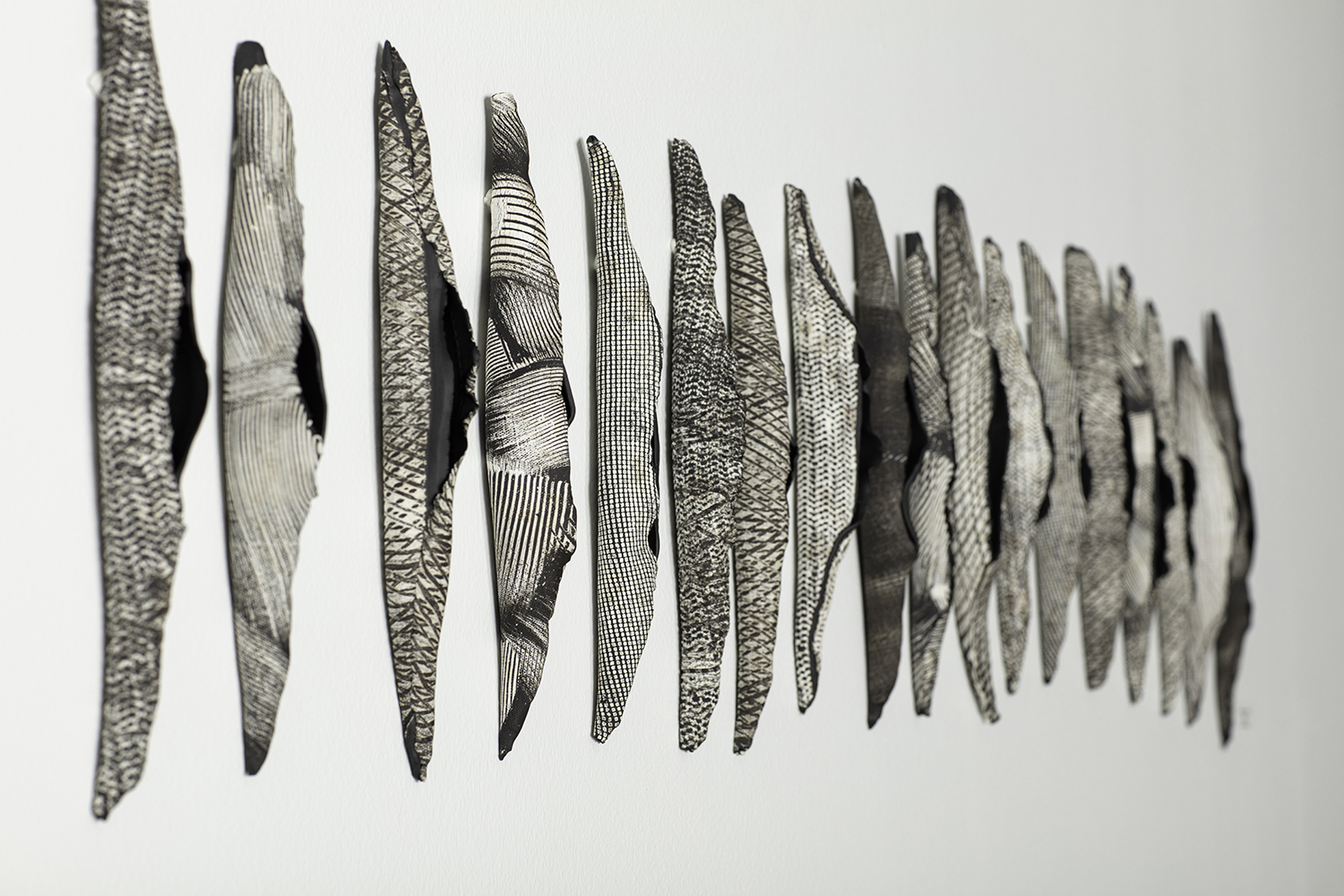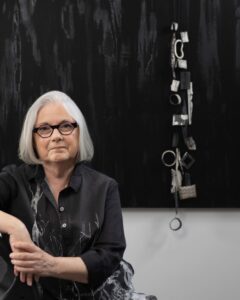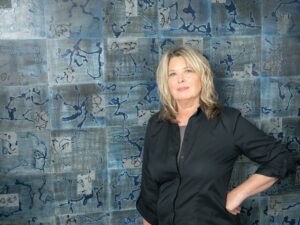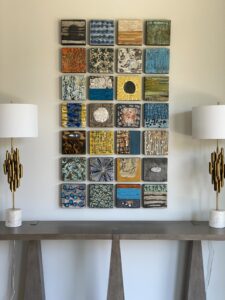Concrete and Clay

Writer Shannon Severson
Photography Courtesy of Grace Renee Gallery
[dropcap]T[/dropcap]he idea of art might first bring to mind a canvas; a swath of color splashed across a flat surface. That would be accurate but what a delight it is when our eyes witness the broader definition and take us into beautiful frontiers we had not at first considered.
Concrete and Clay, which comes to Carefree’s Grace Renee Gallery Nov. 4, is a showcase of rich complexity in material, pattern, style and inspiration by two remarkably talented artists: Kathleen Hope and Jodi Walsh.
An art consultant began putting their work together. When they first spoke by phone there was an immediate connection.
“After the first telephone call, our careers just meshed and we pass information and leads back and forth constantly,” Walsh says.
The pair eventually met in person in Arizona. Hope, a native of Minnesota who now lives in Fountain Hills, counts their meeting and path to working together as serendipity.
“There is a saying in the art field, ‘Art that can live in the same space has a similar sensitivity,” she explains.
Walsh adds that she and Hope immediately felt a connection personally and in their work. The two struck up a friendship.
“Serendipity is this chance occurrence when something unexpected happens in a beneficial way,” Hope explains. “To truly make serendipity happen, it takes a leap of faith. It is not enough to have insight and allow the accident to occur. It requires action because there is great courage in being OK with not knowing what is possible but pursuing it anyway.
“In art, this marriage of voice and material is difficult to find. It has to stand the test of time while allowing an infinite amount of creating outcomes.”
The Imprint of the World



Walsh is a native of Toronto, Canada. Art and design have always been part of her DNA. She has lived around the world — from Taiwan to Europe, East Africa to Bangladesh and Calcutta, India — working with world bank, U.S. aid projects and in marketing for U.S. tech companies. Even when resources were exceedingly scarce, she would seek out and find textural elements to create art or clothing.
“I was caught in several internal wars and was evacuated by ship from Bangladesh, East Pakistan at the time to Calcutta, India,” Walsh recounts. “I have lost everything twice in my life. I have a great appreciation for water and electricity. I live in daily gratitude and appreciation.”
She left the U.S. tech industry 20 years ago to create full-time, primarily in mixed media. She was ready for a change and ceramics came to the fore six or seven years ago. She created the process of “Oritatami Nendo” — folding clay. While inspiration is key to any pursuit, Walsh prefers the term discipline to describe her journey and the honing of her entirely unique art form.
“It’s very difficult to come up with something new in the art world — almost impossible,” she says. “I’m a believer that the answer to everything is behind you.
“I looked back on my travels, the countries and people I admired most, how they lived, their lifestyle, what they valued and everything came back to an appreciation of a simple lifestyle., Nothing complicated; minimal esthetics — something as uncomplicated as a fold.
“Every human has their own style. You can see it in their clothes, everything in their house, the food they eat, the company they keep and how they earn a living. My meditation and yoga practice allows me to function during these difficult times. I can’t imagine what it would be like without my artwork.”
Walsh uses a special, environmentally-friendly water-based polymer product without chemicals or waste to create textures. She doesn’t use traditional glazes and her work is in black and white, but within that simple color scheme is an enormous range of pattern and visual interest.
The pieces all vary and invite the viewer to move in close, examining the shape and flow — something that is so curious to the eye that one must peer at each corner and strand to see what is happening. She uses birch panels, clay, wax-covered hemp, metals and stainless steel thread to create cubes, seed pods, scrolls and cocoons.
“I paint, make markings with slip and add texture to slabs of wet clay,” Walsh says. “I then cut, fold and fire to 2,200 degrees so the clay pieces are vitrified, or sturdy. Much of my work is installed in lobbies and conference rooms so it needs to be strong.”
Cement Pioneer



Walsh’s dedication in creating this new art form was mirrored in what she saw Hope doing with concrete — also something entirely new and different.
Hope’s background was as a color consultant for interior and exterior design — particularly stucco, wall paint and staining — but she has also worked as a fine artist. She studied decorative painting with a master painter from Berlin with whom she apprenticed for a year. At the time she worked in oil, pastel and then collage and mixed media.
No matter the material, it was color that Hope perceives so acutely and allowed her to take that talent into new surfaces and forms. Her desire to create art using a material with texture and uniqueness led her to choose cement as her medium. She mixes it with varying materials like dried pigment, paper and marble dust, applying color using stains, inks, acid, pigment and acrylic.
“Color has always come easy for me,” Hope says. “It is learned, but you also realize that no one sees color the same. I can see minute changes in color and I can also look at a color and know what combinations of tint go into making that color.”
To further her career education, Hope completed accredited coursework through the International Association of Color Consultants/Designers in North America. Color is very personal to her and it was always something about which she closely consulted with her clients. She believes every person has connections with color throughout their lives and it plays an enormous role in our personalities, experiences and how we live and work in our own space.
“Everyone has an emotional response to color, negative and positive,” Hope says. “Sometimes this response can come from childhood. We can all recall a time that some incident has triggered a response to color; this can sometimes carry throughout our lives. Some are more sensitive to color, as well. I tend to be more introverted than extroverted. Introverts tend to like less clutter, less color saturation. In other words, I prefer Sedona versus Las Vegas.”
Her start in concrete began with a client request for an outdoor painting when she moved to Arizona. She had to master its use in a painterly way with lots of trial, error and determination, becoming “fluent in cement.”
“My response was, ‘Could you give a year?” she says. “Concrete kept coming top in my research as being most reliable for outdoor application. I started experimenting with different mixes and, after a year, painted the outdoor art for that client. I never looked back because it gave me what I was looking for; I could tint into the mixture, paint over it and pour it for texture.”
The unpredictable and porous nature of cement, as well as its extreme temperature sensitivity, requires a precise studio temperature and exacting attention to detail for consistent results. The material dries very quickly and color is difficult to erase once applied.
Hope’s work has a magical quality that results from all of the elements she adds, sometimes with brushes, squeeze bottles and industrial tools. It draws you in to see what, exactly, you’re witnessing — beautiful, colorful permanence with texture, pattern and intriguing little surprises.
Carefree Convergence



Concrete and Clay is a celebration of these art forms — an inspiring treat to expand the mind beyond any canvas. Both women are excited to bring the exhibition to Grace Renee Gallery with the help of owner Shelly Spence.
“When you find a good fit with a gallery, it really is a gift to be treasured,” Walsh says. “It’s such an honor to be included in the Grace Renee Gallery group of artists. Shelly Spence is a delight to work with and her commissions test my creative abilities, which I love.”
Hope concurs.
“Shelly contacted me to be a part of her gallery and I’ve been showing with her from the start,” she says. “She is an excellent businesswoman and has a great eye for art. I am fortunate to be a part of this outstanding group of artists.”
Concrete and Clay
Thursday, Nov. 4 // 4–7 p.m. // Grace Renee Gallery // Historic Spanish Village // 7212 E. Ho Hum Road, #7, Carefree // Free // 480-575-8080 // gracereneegallery.com

